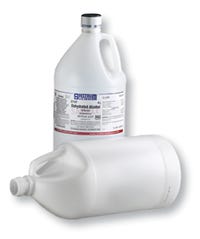January 30, 2014
Spectrum Chemicals & Laboratory Products, Gardena, CA, supplies some 15,000 high-purity, fine chemicals to a variety of industries and offers active pharmaceutical ingredients, laboratory supplies and more.
 Considered one of the largest fine chemicals manufacturers of both inorganic and organic chemical products in the U.S., Spectrum offers certain products that can run up against problems if contained in certain types of plastic containers.
Considered one of the largest fine chemicals manufacturers of both inorganic and organic chemical products in the U.S., Spectrum offers certain products that can run up against problems if contained in certain types of plastic containers.
Some dyes can stain plastic, and solvents can eat away at plastic or soften it to the touch. That's why for years, the company has packaged its chemicals in amber glass bottles. The chemicals came in bottles sizes from 500 mL to 4 L, and most of the glass containers had to be coated or dipped in polyvinyl chloride (PVC) for safety reasons. “If they broke, they had a plastic shield around them,” explains Bill House, Spectrum's director of operations. “But coating the glass was a very costly process.”
While some of the chemicals Spectrum produces are not compatible with plastic containers and must continue to be packaged in glass, the majority of the acid and polar solvent–based products are being transferred to plastic bottles. When Spectrum decided to convert to plastic in a major way, House says it needed a high-quality material that would be compatible with most of the products. Spectrum decided that high-density polyethylene (HDPE) was the most suitable material choice, because HDPE bottles could reduce shipping costs and resist breakage. “We produce various high-purity chemicals, so we have to use plastic that doesn't leach molecules or residue into the chemicals,” says House. “For this reason, HDPE [resin] was the choice.”
Facilitates production
Already using 4-L HDPE jugs with great success, Spectrum turned to Novapak Corp. (www.pvcc.com) to replace the 1-L and 500-mL glass bottles with unpigmented HDPE containers of the same sizes, which Novapak has recently introduced. Spectrum finds that the HDPE bottles—Novapak's stock Airopak bottles—are lowering costs to customers by 25 to 50 percent. And thankfully, the HDPE bottles don't leach molecules or residue. They also weigh as much as 11 times less than the glass containers, which contributes to a reduction in shipping costs.
Novapak's molding process involves the use of filtered nitrogen as the blowing gas, which maintains cleanliness. It extrusion/blow-molds Spectrums' new Bullet Round HDPE bottles at its facility in Manchester, PA, on Bekum (www.bekum.de) equipment using a proprietary resin and then caps the containers to ensure cleanliness of the particulate-sensitive chemicals. Each of the three new bottles sports a 38/439 neck finish, which helps to keep cap inventory low, and are similar in shape to their glass counterparts. The bottle necks are also wider than the previous bottles' 33- and 28-mm neck finishes, which makes the plastic versions easy to fill and to pour.
Several types of closures from several sources are used to cap the containers, depending on the products being packed, House says.
Alan Wood, Novapak's vp of business development/specialty containers, tells PD that the bottles aren't technically classified as being sterile or sanitized, but they ought to be. “These ultra-clean bottles are filtered using nitrogen gas,” he says. “Immediately after we mold the bottles, we cap them with temporary snap-caps to minimize particulate contamination inside.”
The lightweight temporary snap-caps are removed just prior to filling. After filling, a conventional 38/489 screw cap is applied.
Says Wood, “If compressed plant air is used as the blow gas, it could introduce unwanted particulates or oils into the container, contaminating the ultra-pure products. Most users find no reason to rinse these HDPE containers. The resin used to produce them is very clean, or 'barefoot,' in that it is devoid of additional processing aids or additives.”
Wood also says the particular HDPE bottle resin was selected for both its superior stress-crack-resistance and it's ability to accept in-line fluorination. By themselves, the bottles have good resistance to polar solvents (acids and alcohols), and when we in-line fluorinate the bottles, the HDPE demonstrates excellent resistance to nonpolar solvents (oil-based chemicals such as xylene, toluene and d-limonene, the latter an oil-based solvent derived from orange peels).”
Adds House, “Novapak was about the only one that offered bottles in these sizes. Other sizes just didn't fit our application.” According to Wood, Novapak will soon add a 2.5-L plastic container to its line as part of an expansion into the specialty container market.
Wood also notes that the resin offers superior stress-crack-resistance and is able to accept in-line fluorination.
The bottles can also withstand high pressure without distortion, due to the special design of their pressure-bottom base, he says.
Shipping fast for less
Once the bottles are filled and capped, they're case-packed into six-count corrugated reshippers provided through Novapak by York Container (www.yorkcontainer.com). The lightweight HDPE bottles have reduced the need for inner packaging materials such as partitions and inserts that were previsouly included in shipping cases, adds DeLeon, thereby reducing shipping costs 15 to 20 percent. Labor has been reduced from about eight to five hours per 1,000 bottles.
“Customers have responded positively about saving on freight charges. And the containers don't compromise safety,” House concludes. “These containers pass UN testing for many products.”
More information is available: |
Novapak Corp., 800/975-2784. www.pvcc.com. |
Bekum Maschinenfabriken GmbH, 49 (0) 30 7490-2290. www.bekum.de. |
York Container, 717/757-7611. www.yorkcontainer.com. |
About the Author(s)
You May Also Like


